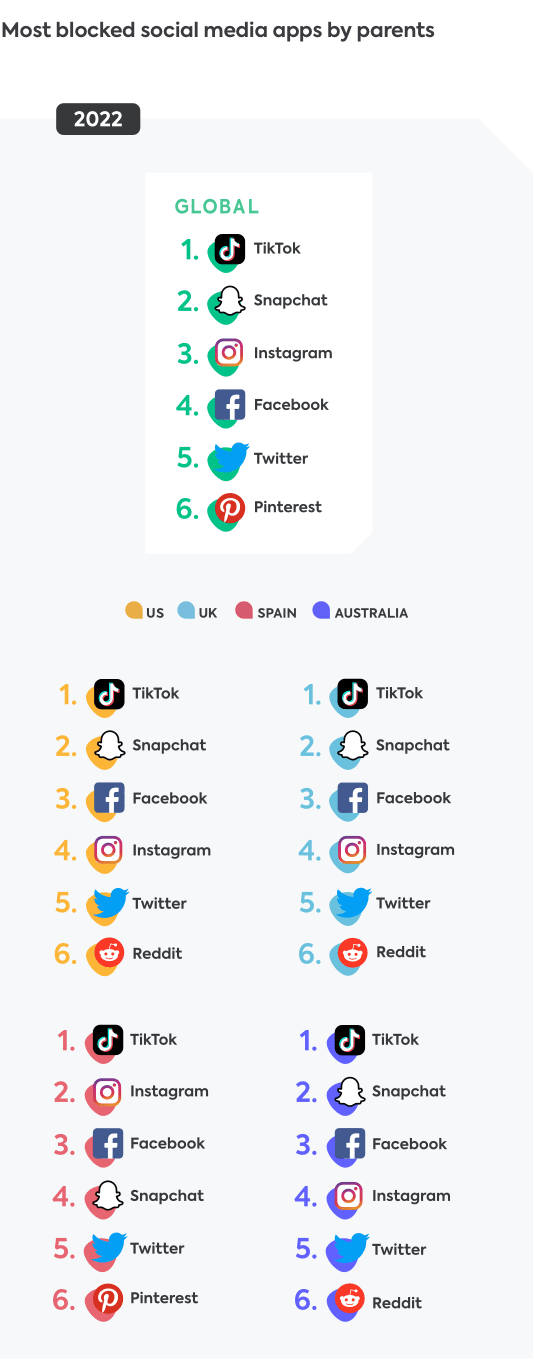RESEARCH BY APP CATEGORY
Social
media

What we found for social media apps
If 2021 was the year social media use raised a few eyebrows in the family, 2022 went one hair-raising step further. Children’s use of social media apps continued to climb across the year, with global time spent on social platforms increasing by 12%.
The eyes fixated on Twitter following Elon Musk’s controversial takeover were also reflected among younger users: Twitter experienced a 7% growth in popularity worldwide, one of the most significant increases in the social media category.
As Instagram and parent company Meta fought to stay relevant, TikTok dominated the media, with reports that Gen Z were now even turning to the social media giant ahead of Google to find answers to their burning questions online. With the video-sharing app as their new go-to search engine, kids spent 18% longer on TikTok in 2022, ringing in the year with an average daily usage of 107 minutes – that’s 60% longer than time spent on video content on YouTube.
THE MOST POPULAR SOCIAL MEDIA APPS
For yet another year, TikTok dominated the top spot globally and in all countries analyzed. 1 in 2 kids in the UK now uses TikTok, while almost 2 in 3 children in Spain (61%) are fans of the seemingly unstoppable social media giant. Against all odds, Facebook’s popularity among younger users slightly grew across 2022, with 38% of kids helping it to claim second place globally.
Snapchat maintained its global third position, but rose to second place in the UK, with 46% of kids using the app, and dropped to fourth position in the US, behind new top 3 contender Pinterest, which 40% of US children now use.
2022 was not Instagram’s year, falling completely out of the top 5 most popular social media in Australia, the US, and the UK. The app’s saving grace was found in Spain, where children continued to show their devotion to Instagram, with 51% of kids helping it secure second place in the country.





HOW MUCH TIME DID CHILDREN SPEND ON SOCIAL MEDIA IN 2022?
Inevitably, children spent the most time on TikTok across 2022, with daily minutes spent rising from 91 in 2021, to 107 minutes – an average of almost 2 hours a day. The strongest growth in time spent on TikTok was seen in Australia, where kids spent 44% more time on the video sharing app across the year, averaging 108 daily minutes.
Australian children upped their time on most of the social media giants, spending 31% more time on Snapchat (84 mins/day versus 64), and 20% more time on Instagram, despite the app not entering the top 5 in popularity. The only country where children decreased their time on Snapchat was Spain, where usage dropped from 24 daily minutes in 2021 to just 21 in 2022. And despite its surge in popularity, time spent on Twitter showed either no change or decreased, with the largest drop seen in the UK – just 9 daily minutes versus 12 in 2021.





Social media was one of only two categories in our report which continued to experience yearly growth in time spent, with a 12% increase from 2021 globally. In Australia, these usage levels climbed to even higher heights, with children increasing their time on social platforms by 17%.
Social media use remained relatively stable throughout the year, and children found it difficult to switch off even during school season. Kids’ lowest usage was 49 minutes a day, seen in November in Spain, and August in Australia. The year’s record for average daily use, at 65 minutes, was set by kids in the UK over their end-of-term holidays in April.
THE MOST BLOCKED SOCIAL MEDIA APPS IN 2022
Following security debates across 2022, TikTok held fast in its position as the number 1 blocked app by families worldwide – and in all countries analyzed. Perhaps reflecting Twitter’s opinion-dividing sale to Elon Musk, the microblogging network appeared in the top 5 most blocked social media apps for the first time in 2022, behind regular contenders Instagram, Snapchat, and Facebook.



What we expect for social media apps
With social media now playing a huge part in shaping the younger generations and how they interact online, we expect parental pushback to continue to grow. From US bill proposals of a TikTok ban for under-18s, to France’s president, Emmanuel Macron, beginning to call for better protection for children on social networks, it’s clear lawmakers and government bodies are looking for ways to help social media become a healthier, less damaging space for young people online.
Instagram’s parental supervision features were rolled out in multiple countries in early 2022, with Snapchat’s Family Center following suit in August, allowing parents to see their teen’s Snap contacts and easily report concerning accounts. As social media use continues to grow among the younger generations, we expect the tools provided to parents to help monitor this use will become more extensive. After all, social media companies have no desire to cut off one of their primary audiences, and parental supervision is the olive branch serving to persuade families of their commitment to online safety.
Many lawmakers believe this isn’t enough, and talks of online safety bills and changes to existing legislation have been rumbling across 2022. While slow-going, we anticipate that many new bills and regulations will come into effect over the coming years to help promote children’s online safety and support their mental health on social networks.
What we recommend for social media apps

Trends move fast on social media, along with the rise (and fall) of popular networks. As seen from growing interest in more recently developed social apps like BeReal and Yubo over the course of 2022, there’s always something fresh to learn. Families don’t have to be the most social media savvy, but keeping up-to-date on trends can help parents to stay prepared. Talking to teens about what they like and dislike about their current favorite platforms is a simple way parents can stay on top of the curve, rather than falling behind.
I only use social media to keep up-to-date about actors, movies and singers I like. What I like is seeing interesting things that some people can do, like crafts, inventions, or art and drawings.”
– Girl, 13, Spain

No matter the peer pressure, we recommend only allowing kids to create a social media account when they demonstrate the appropriate level of emotional maturity. Just like they do with real-world dangers, adults need to prepare children for risks in the digital world: families need to open up the conversation surrounding the many problematic aspects of social media, and the potential dangers it can expose younger users to.
– Girl, 11, Australia

Before allowing children to use social media, parents should become more familiar with the platforms themselves, and be heavily involved in the initial setup process of the profile to ensure the correct privacy settings are applied (private profile, friend and family requests only, location settings off). They can also help their child find and follow individuals and content that ties in with their family’s values. To help establish healthier digital relationships, parents can also set time limits on social media apps, limiting scroll time on apps with bottomless content such as TikTok and Instagram.


Keeping teenagers completely off social media is now an almost impossible task, thanks to the proliferation of apps like TikTok and Snapchat in popular culture. Nowadays, there’s always someone in the class or the friendship group with access to social media. Many parents resort to banning children completely from social media, but most tech-savvy kids will still find a way to use the apps. Social media, when used correctly, can be a tool for creativity and provide opportunities for social interaction. Instead of sending children unequipped to face the risks social media poses, help them understand the differences between the real world and the social media one – and how to face the distorted online reality they’ll be faced with.
– Girl, 13, Spain

Download your copy of the Report “From Alpha to Z: raising the digital generations” plus the Annex with all the data.